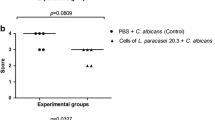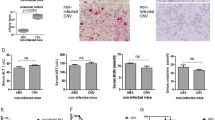Abstract
Objective
This study aimed to investigate the influence of Lactobacillus rhamnosus intake on the development of candidiasis and cytokines release.
Material and methods
Candida suspensions were inoculated into the oral cavity of experimentally immunosuppressed mice for candidiasis induction. The animals were divided into experimental groups: candidiasis with no probiotic intake (F), candidiasis with probiotic intake during Candida inoculation (FP), and candidiasis with probiotic intake 14 days before inoculation with Candida (FPP); and control groups: (C), (CP), and (CPP) without inducing candidiasis with probiotic intake in the same manner as groups F, FP, and FPP, respectively. After these periods, samples were collected from the oral cavity for yeast counts and, after euthanasia, the tongues of the animals were removed for histological analysis. Sera samples were also collected for analysis of IL-1 beta, TNF-alpha, INF-gamma, IL-12, IL-4, and IL-10.
Results
FP group showed lower Candida counts in the oral cavity, and the presence of Candida was almost not detected in FPP group. In tissues, the counts of fungi were significantly lower in FPP group, followed by FP. Groups that consumed probiotics also had lower histological and inflammatory infiltrates compared to F. Cytokines analysis demonstrated low concentrations of TNF-α, IL-12, IL-4, and IL-10 in all the groups, and no statistical difference between them. The production of IL-6 could be better detected, and the experimental groups that consumed the probiotic showed significant lower levels of this cytokine.
Conclusions
The results suggest that L. rhamnosus intake, especially preventively, may avoid or decrease the development of candidiasis in immunosuppressed mice.
Clinical relevance
This work adds scientific evidences that probiotics intake can avoid the development of candidiasis.





Similar content being viewed by others
References
FAO/WHO (2002) Guidelines for the evaluation of probiotics in food. Food and Agriculture Organization of the United Nations/World Health Organization, London
Kumar M, Babaei P, Ji B, Nielsen J (2016) Human gut microbiota and healthy aging: recent developments and future prospective. Nutr Healthy Aging 4(1):3–16. https://doi.org/10.3233/NHA-150002
Iannitti T, Palmieri B (2010) Therapeutical use of probiotic formulations in clinical practice. Clin Nutr 29(6):701–725. https://doi.org/10.1016/j.clnu.2010.05.004
Al-Salami H, Caccetta R, Golocorbin-Kon S, Mikov M (2012). Probiotics applications in autoimmune diseases. In: Rigobelo EC(ed). Probiotics. InTech, Rijeka, pp 325–366
Shteyer E, Wilschanski M (2008) Novel therapeutic modalities in pediatric inflammatory bowel disease. Isr Med Assoc J 10(11):816–820 http://www.ncbi.nlm.nih.gov/pubmed/19070296
Gupta V, Garg R (2009) Probiotics. Indian J Med Microbiol 27(3):2002–2009. https://doi.org/10.4103/0255-0857.53201
Richardson M, Rautemaa R (2009) How the host fights against Candida infections. Front Biosci (Schol Ed) (1):246–257. http://www.ncbi.nlm.nih.gov/pubmed/19482700, S1. https://doi.org/10.2741/s24
Pinto TMS, Neves ACC, Leão MVP, Jorge AOC (2008) Vinegar as an antimicrobial agent for control of Candida spp. in complete denture wearers. J Applied Oral Science (Online) 16(6):385–390. https://doi.org/10.1590/S1678-77572008000600006
Querido SMR, Brito GN, Santos SSF, Leão MVP, Ito CYK, Jorge AOC (2011) Opportunistic microorganisms in patients undergoing antibiotic therapy for pulmonary tuberculosis. Braz J Microbiol 42(4):1321–1328. https://doi.org/10.1590/S1517-838220110004000012
Silva CRG, Oliveira LD, Leão MVP, Jorge AOC (2014) Candida spp. adherence to oral epithelial cells and levels of IgA in children with orthodontic appliances. Braz Oral Res 28(1):28–32. https://doi.org/10.1590/S1806-83242013005000031
Shalev E, Battino S, Weiner E, Colodner R, Keness Y (1996) Ingestion of yogurt containing Lactobacillus acidophilus compared with pasteurized yogurt as prophylaxis for recurrent candidal vaginitis and bacterial vaginosis. Arch Fam Med 5(10):593–596 http://www.ncbi.nlm.nih.gov/pubmed/8930233
Hatakka K, Ahola AJ, Yli-Knuuttila H, Richardson M, Poussa T, Meurman JH, Korpela R (2007) Probiotics reduce the prevalence of oral Candida in the elderly—a randomized controlled trial. J Dent Res 86(2):125–130. https://www.ncbi.nlm.nih.gov/pubmed/17251510
Dos Santos AL, Jorge AOC, Santos SSF, Silva CRG, Leão MVP (2009) Influence of probiotics on Candida presence and IgA anti-Candida in the oral cavity. Braz J Microbiol 40(4):960–964. https://doi.org/10.1590/S1517-838220090004000030
Mendonça FHBP, Santos SSF, Faria IS, Silva CRG, Jorge AOC, Leão MVP (2012) Effects of probiotics bacteria on Candida presence and IgA anti-Candida in the oral cavity of elderly. Braz Dent J 23(5):534–538. https://doi.org/10.1590/S0103-64402012000500011
Villena J, Salva S, Agüero G, Alvarez S (2011) Immunomodulatory and protective effect of probiotic Lactobacillus casei against Candida albicans infection in malnourished mice. Microbiol Immunol 55(6):434–445. https://doi.org/10.1111/j.1348-0421.2011.00334.x
Oliveira VM, Santos SS, Silva CR, Jorge AO, Leão MV (2016) Lactobacillus is able to alter the virulence and the sensitivity profile of Candida albicans. J Appl Microbiol 121(6):1737–1744. https://doi.org/10.1111/jam.13289
Charan J, Kantharia ND (2013) How to calculate sample size in animal studies? J Pharmacol Pharmacother 4(4):303–306. https://doi.org/10.4103/0976-500X.119726
Dongari-Bagtzoglou A, Kashleva H, Dwivedi P, Diaz P, Vasilakos J (2009) Characterization of mucosal Candida albicans biofilms. PLoS One 4(11):e7967. https://doi.org/10.1371/journal.pone.0007967.
Rossoni RD, Fuchs BB, de Barros PP, Velloso MD, Jorge AO, Junqueira JC, Mylonakis E (2017) Lactobacillus paracasei modulates the immune system of Galleria mellonella and protects against Candida albicans infection. PLoS One 12(3):e0173332. https://doi.org/10.1371/journal.pone.0173332
Wagner RD, Johnson SJ (2012) Probiotic lactobacillus and estrogen effects on vaginal epithelial gene expression responses to Candida albicans. J Biomed Sci 19(1):58. https://doi.org/10.1186/1423-0127-19-58
Habil N, Murrani WA, Beal J, Foey AD (2011) Probiotic bacterial strains differentially modulate macrophage cytokine production in a strain-dependent and cell subset-specific manner. Benef Micro 2(4):283–293. https://doi.org/10.3920/BM2011.0027
Gozalbo D, Maneu V, Gil ML (2014) Role of IFN-gamma in immune response to Candida albicans infections. Front Biosci (Landmark Ed) 19:1279–1290 http://www.ncbi.nlm.nih.gov/pubmed/24896350
Zhang H, Chen H, Niu J, Wang Y, Xie L (2009) Role of adaptive immunity in the pathogenesis of Candida albicans keratitis. Invest Ophthalmol Vis Sci 50(6):2653–2659. https://doi.org/10.1167/iovs.08-3104.
Uddin MN, Siddig A, Oettinger CW, D’Souza MJ (2011) Potentiation of pro-inflammatory cytokine suppression and survival by microencapsulated dexamethasone in the treatment of experimental sepsis. J Drug Target 19(9):752–760. https://doi.org/10.3109/1061186X.2011.561856
Morgan DJ, Davis DM (2017) Distinct effects of dexamethasone on human natural killer cell responses dependent on cytokines. Front Immunol 8:432. https://doi.org/10.3389/fimmu.2017.00432
Samaranayake YH, Samaranayake LP (2001) Experimental oral candidiasis in animal models. Clin Microbiol Rev 14(2):398–429. https://doi.org/10.1128/CMR.14.2.398-429.2001
Metwalli KH, Khan SA, Krom BP, Jabra-Rizk MA (2013) Streptococcus mutans, Candida albicans, and the human mouth: a sticky situation. PLoS Pathog 9(10):e1003616. https://doi.org/10.1371/journal.ppat.1003616
Traynor TR, Huffnagle GB (2001) Role of chemokines in fungal infections. Med Mycol 39:41–50. http://mmy.oxfordjournals.org/content/39/1/41.1.long. https://doi.org/10.1080/mmy.39.1.41.50
Huang W, Na L, Fidel PL, Schwarzenberger P (2004) Requirement of interleukin-17A for systemic anti-Candida albicans host defense in mice. J Infect Dis 190(3):624–631. https://doi.org/10.1086/422329
Funding
The work was supported by Fundação de Amparo à Pesquisa de São Paulo (FAPESP).
Author information
Authors and Affiliations
Corresponding author
Ethics declarations
Conflict of interest
The authors declare that they have no conflict of interest.
Ethical approval
All applicable international, national, and/or institutional guidelines for the care and use of animals were followed.
Informed consent
For this type of study, formal consent was not required.
Rights and permissions
About this article
Cite this article
Leão, M.V.P., Tavares, T.A.A., Gonçalves e Silva, C.R. et al. Lactobacillus rhamnosus intake can prevent the development of Candidiasis. Clin Oral Invest 22, 2511–2518 (2018). https://doi.org/10.1007/s00784-018-2347-8
Received:
Accepted:
Published:
Issue Date:
DOI: https://doi.org/10.1007/s00784-018-2347-8




